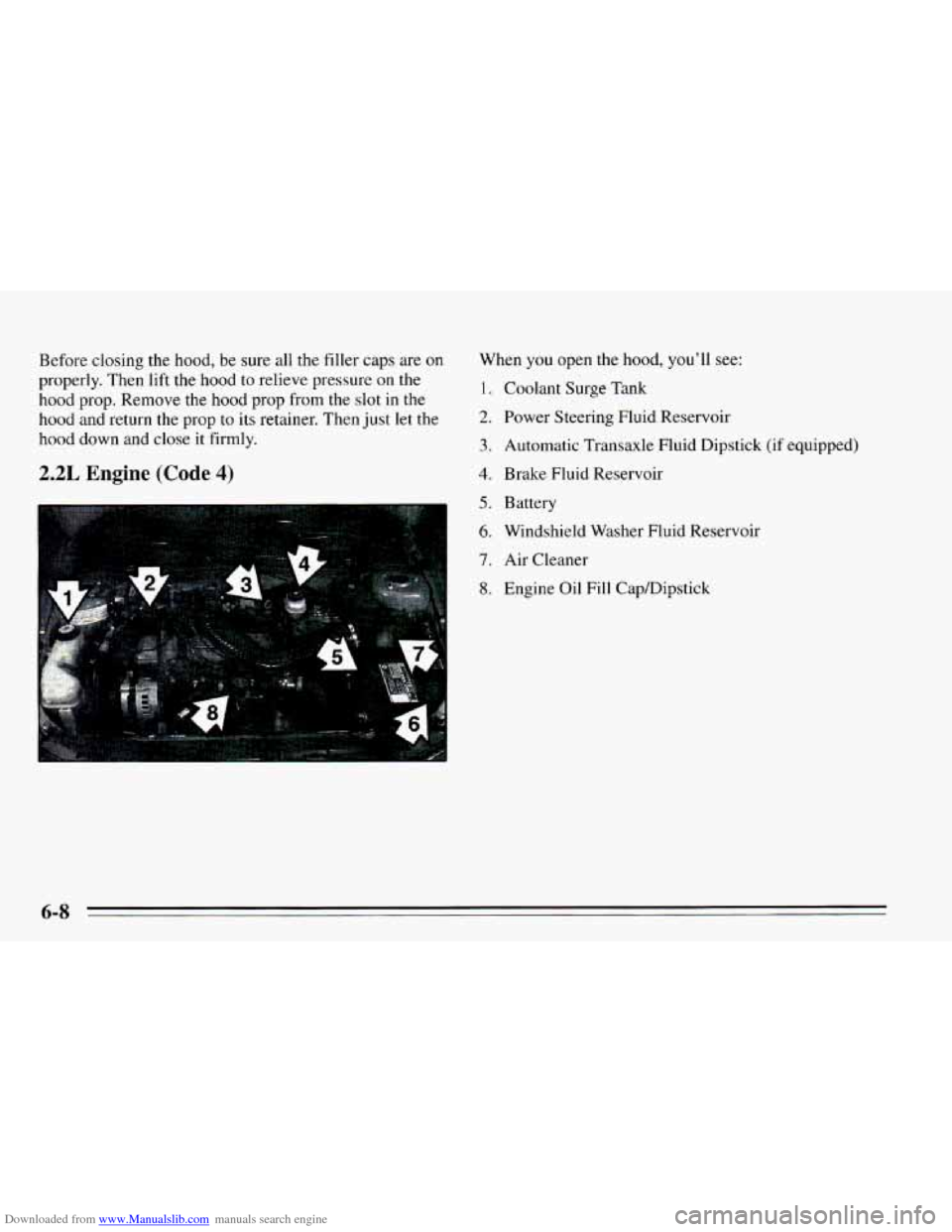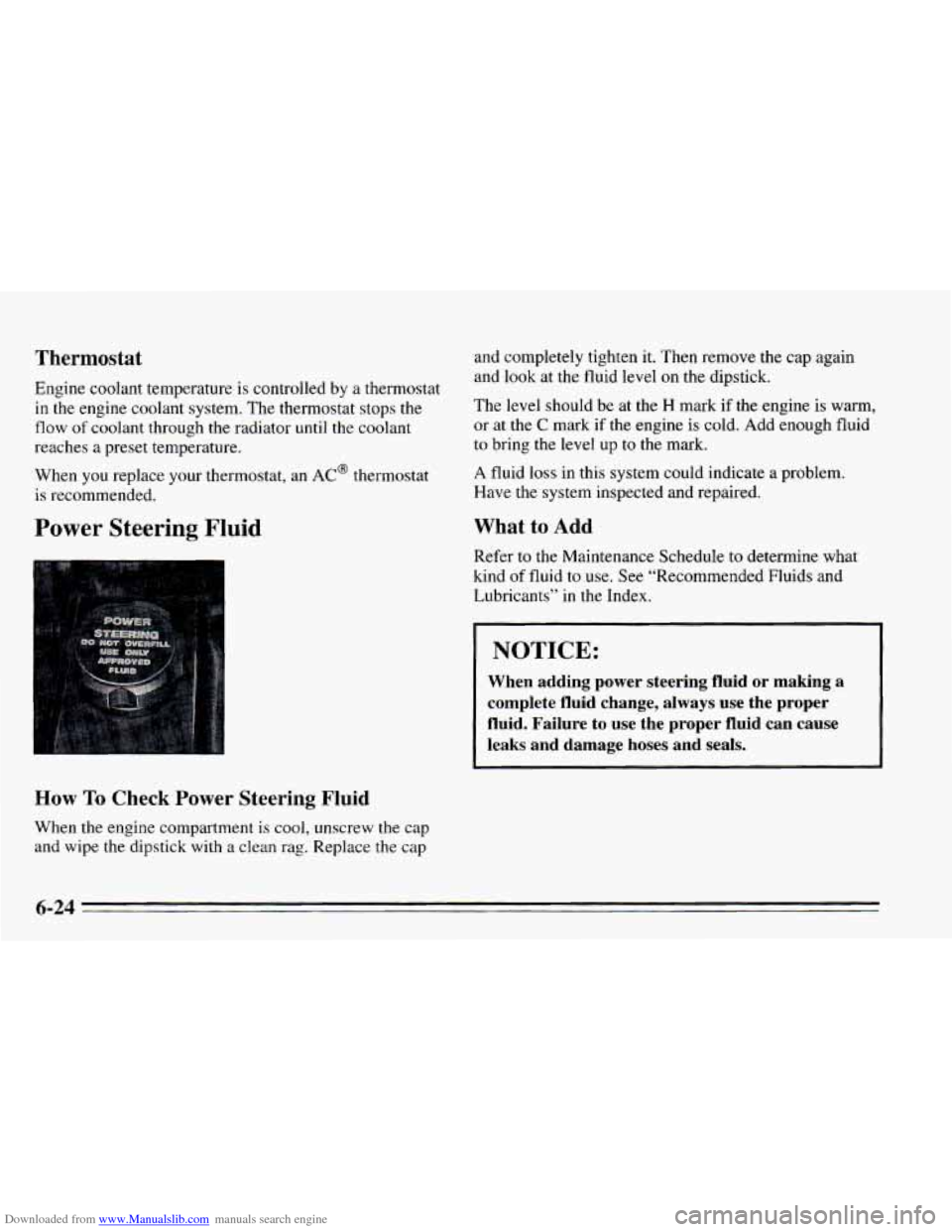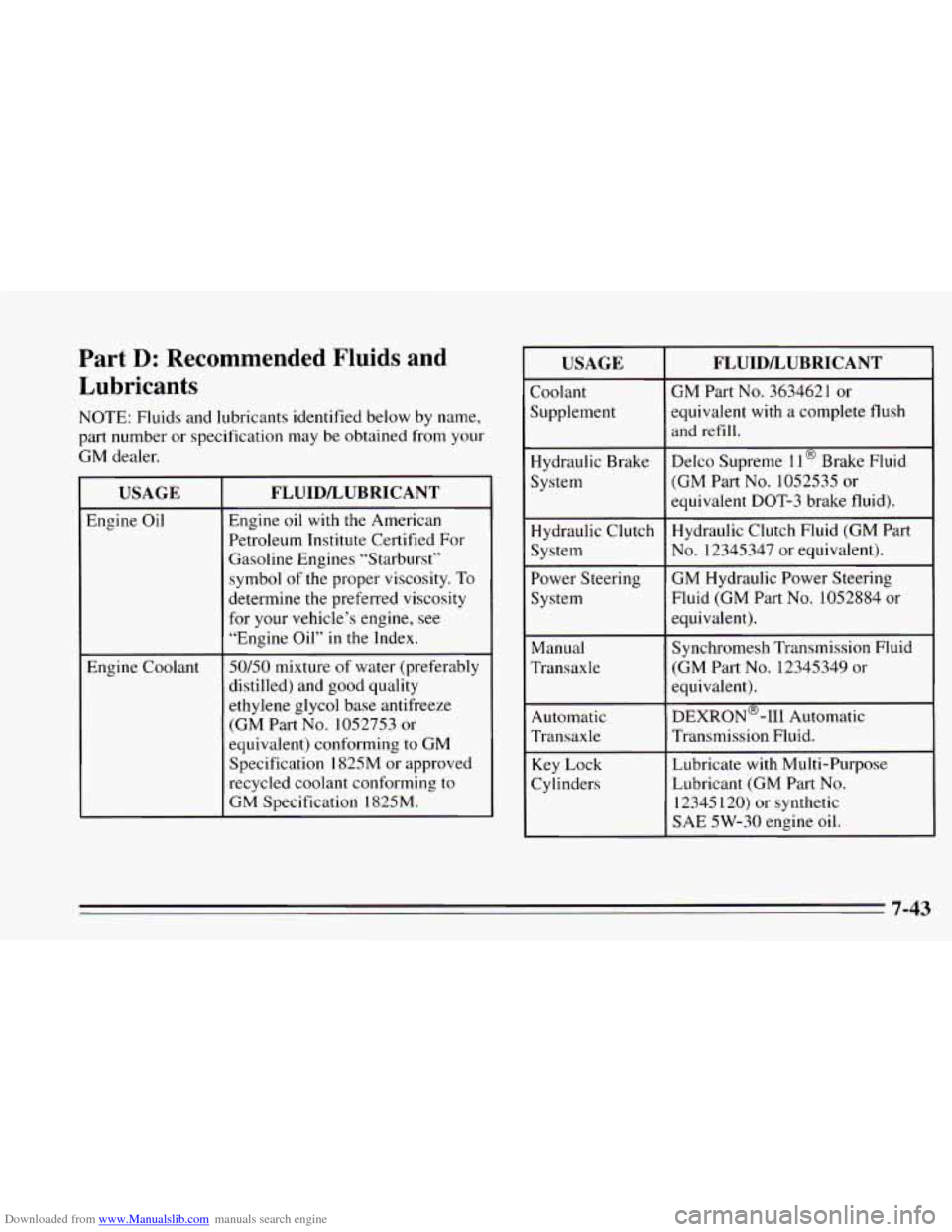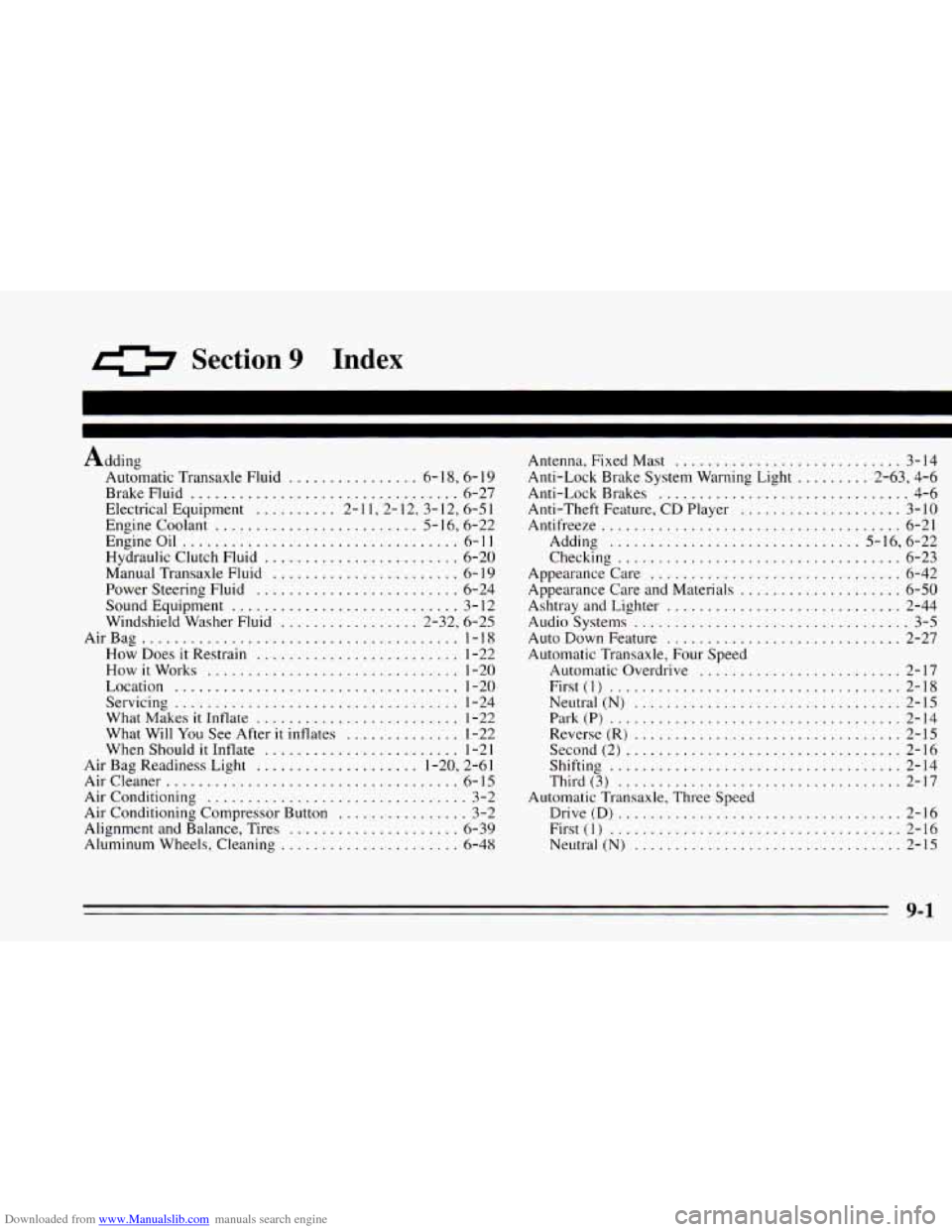1995 CHEVROLET CAVALIER power steering fluid
[x] Cancel search: power steering fluidPage 212 of 340

Downloaded from www.Manualslib.com manuals search engine Before closing the hood, be sure all the filler caps are on
properly. Then lift the hood to relieve pressure
on the
hood prop. Remove the hood prop from the slot in the
hood and return
the prop to its retainer. Then just let the
hood down and close it firmly.
2.2L Engine (Code 4)
When you open the hood, you’ll see:
1. Coolant Surge Tank
2. Power Steering Fluid Reservoir
3. Automatic Transaxle Fluid Dipstick (if equipped)
4. Brake Fluid Reservoir
5. Battery
6. Windshield Washer Fluid Reservoir
7. Air Cleaner
8. Engine Oil Fill Capmipstick
Page 213 of 340

Downloaded from www.Manualslib.com manuals search engine 2.3L Engine (Code D) When you open the hood, you’ll see:
1.
2.
3.
4.
5.
6.
7.
8.
9.
Coolant Surge Tank
Power Steering Fluid Reservoir
Engine
Oil Dipstick
Brake Fluid Reservoir
Hydraulic Clutch Fluid Reservoir
(if equipped)
Battery
Windshield Washer Fluid Reservoir
Air Cleaner
Engine Oil Fill Cap
6-9
Page 228 of 340

Downloaded from www.Manualslib.com manuals search engine Thermostat
Engine coolant temperature is controlled by a thermostat
in the engine coolant system. The thermostat stops the
flow of coolant through the radiator until the coolant
reaches
a preset temperature.
When
you replace your thermostat, an AC’ thermostat
is recommended.
Power Steering Fluid
How To Check Power Steering Fluid
When the engine compartment is cool, unscrew the cap
and wipe the dipstick with a clean rag. Replace the cap and
completely tighten
it. Then remove the cap again
and look at the fluid level
on the dipstick.
The level should be at the
H mark if the engine is warm,
or at the
C mark if the engine is cold. Add enough fluid
to bring the level up
to the mark.
A fluid loss in this system could indicate a problem.
Have the system inspected and repaired.
What to Add
Refer to the Maintenance Schedule to determine what
kind
of fluid to use. See “Recommended Fluids and
Lubr’
nts” in the Index.
I NOTICE:
~~
When adding power steering fluid or making a
complete fluid change, always use the proper
fluid. Failure to use the proper fluid
can cause
leaks and damage hoses and seals.
6-24
Page 259 of 340

Downloaded from www.Manualslib.com manuals search engine 4.0 quarts 3.80 L
Capacities and Specifications
Enginecrankcase ...........................................
Automatic Transaxle
When chcwging$lte& more oil! rnuy be needed.
Pan Removal and Replacement ................................
When draining or replacing torque convertec 1nore.fluid may be needed.
Complete Drain and Refill ....................................
After Complete Overhaul .....................................
Manual Transaxle
Cooling System
2.2L ...................................................... 10.3 quarts 9.8 L
2.3L
...................................................... 10.7 quarts 10.1 L
Refrigerant (R-l34a), Air Conditioning ......................... See refrigerant charge label under hood.
Not all air conditioning refrigerants are the same. If the air conditioning system in your vehicle needs refrigerant, he sure the
proper refrigerant is used. IJ’you ’re not sure, ask your Chevrolet dealer:
For additionul information, see your “Warrunty and
Owner Assistunce Infixmution, ” booklet.
FuelTank ...............................................
Power Steering
PumpOnly ................................................ 1 .OO pint 0.47 L
Complete System ........................................... 1.14 pints 0.54 L
Tire Pressures, Sizes
.......................................... See Tire-Loading Information label
on driver’s door.
WheelNutTorque ........................................... 100 Ib-ft
4.0 quarts
6.9 quarts
2.0 quarts
15.2 gallons
3.80 L
6.60 L
I .90 L
57.5 L
140 N.m
NOTE: All capacities are approximate. When adding, be sure to fill to the appropriate level, as reconmended in this
manual.
6-55
Page 304 of 340

Downloaded from www.Manualslib.com manuals search engine Part C: Periodic Maintenance
Inspections
Listed below are inspections and services which should
be performed at least twice a year (for instance, each
spring and fall). You should let your
GM dealer’s
service department or other qualified service center do
these
jobs. Make sure any necessary repairs are
completed at once.
Restraint Systems
Now and then, make sure all your belts, buckles, latch
plates, retractors, anchorages and reminder systems are
working properly. Look for any loose parts or damage.
If you see anything that might keep a restraint system
from doing its job, have it repaired.
Steering, Suspension and Front-Wheel-Drive
Axle Boot and Seal Inspection
Inspect the front and rear suspension and steering
system for damaged, loose or missing parts, signs
of
wear, or lack of lubrication. Inspect the power steering
lines and hoses for proper hookup, binding, leaks,
cracks, chafing, etc. Clean and then inspect the drive
axle boot seals for damage, tears or leakage. Replace
seals if necessary.
Exhaust System Inspection
Inspect the complete exhaust system. Inspect the body near
the exhaust system.
Look for broken, damaged, missing or
out-of-position
parts as well as open seams, holes, loose
connections, or other conditions which could cause a heat
build-up in the floor pan or could let exhaust fumes into
the vehicle. See “Engine Exhaust”
in the Index.
Throttle Linkage Inspection
Inspect the throttle linkage for interference or binding, and f\
or
damaged or missing parts. Replace parts
as needed.
Accelerator and cruise control cables should not
be lubricated.
Manual Transaxle
Check the transaxle fluid level; add if needed. See
“Manual Transaxle” in the Index.
A fluid loss may
indicate a problem. Check the system and repair
if needed.
Brake System Inspection
Inspect the complete system. Inspect brake lines and
hoses for proper hookup, binding, leaks, cracks, chafing,
etc. Inspect disc brake pads for wear and rotors for
surface condition.
Also inspect drum brake linings for
wear and cracks. Inspect other brake parts, including
drums, wheel cylinders, calipers, parking brake, etc.
Check parking brake adjustment.
You may need to have
your brakes inspected more often if your driving habits
or conditions result in frequent braking.
7-42
~
Page 305 of 340

Downloaded from www.Manualslib.com manuals search engine Part D: Recommended Fluids and
Lubricants
NOTE: Fluids and lubricants identified below by name,
part number or specification may be obtained from your
GM dealer.
USAGE
Engine Oil
Engine Coolant
FLUIDLUBRICANT
Engine oil with the American
Petroleum Institute Certified For
Gasoline Engines “Starburst”
symbol
of the proper viscosity. To
determine
the preferred viscosity
for your vehicle’s engine, see
“Engine Oil”
in the Index.
50/50 mixture of water (preferably
distilled) and good quality
ethylene glycol base antifreeze
(GM Part No. 1052753 or
equivalent) conforming
to GM
Specification 1825M or approved
recycled coolant conforming to
GM Specification
1825M.
USAGE FLUIDLUBRICANT
Coolant
Supplement GM Part No. 3634621 or
(GM Part No. 1052535 or
System Delco Supreme
11 @ Brake
Fluid
Hydraulic Brake equivalent
with
a complete flush
Hydraulic Clutch Hydraulic Clutch Fluid (GM
Part
System No. 12345347 or equivalent).
Power Steering
GM Hydraulic Power Steering
System Fluid
(GM Part No. 1052884 or
equivalent). and refill.
~~
equivalent DOT-3 brake fluid).
Manual (GM Part
No. 12345349 or
Transaxle Synchromesh
Transmission Fluid
DEXRON@-111 Automatic
Automatic
Transaxle Transmission Fluid.
Key Lock Lubricate with Multi-Purpose
Cylinders Lubricant
(GM Part
No.
12345 120) or synthetic
SAE
5W-30 engine oil.
equivalent).
7-43
Page 327 of 340

Downloaded from www.Manualslib.com manuals search engine 0 Section 9 Index
Adding Automatic Transaxle Fluid
................ 6- 18. 6- 19
BrakeFluid ................................. 6-27
Electrical Equipment
.......... 2-1 1 , 2- 12, 3- 12, 6-5 1
Engine Coolant ......................... 5- 16, 6-22
Engineoil
.................................. 6-11
Hydraulic Clutch Fluid ........................ 6-20
Manual Transaxle Fluid
....................... 6- 19
Power Steering Fluid ......................... 6-24
SoundEquipment
............................ 3-12
Windshield Washer Fluid
................. 2-32, 6-25
AirBag
....................................... 1-18
How Does
it Restrain ......................... 1-22
Howitworks
............................... 1-20
Location
................................... 1-20
Servicing
................................... 1-24
What Makes
it Inflate ......................... 1-22
What Will You See After it inflates .............. 1-22
When Should
it Inflate ........................ 1-2 1
Air Bag Readiness Light .................... 1-20, 2-61
Aircleaner
.................................... 6-15
Air Conditioning ................................ 3-2
Air Conditioning Compressor Button
................ 3-2
Alignment and Balance, Tires
..................... 6-39
Aluminum Wheels, Cleaning ...................... 6-48
Antenna. Fixed Mast ............................ 3-14
Anti-Lock Brake System Warning Light
......... 2.63. 4.6
Anti-Lock Brakes
............................... 4-6
Anti-Theft Feature.
CD Player .................... 3-10
Antifreeze ..................................... 6-21
Adding
............................... 5.16. 6.22
Checking
................................... 6-23
Appearance Care
............................... 6-42
Appearance Care and Materials
.................... 6-50
Ashtray and Lighter ............................. 2-44
Audiosystems
.................................. 3-5
Auto Down Feature
............................. 2-27
Automatic Transaxle.
Four Speed
Automatic Overdrive
......................... 2-17
First(1)
.................................... 2-18
Neutral
(N) ................................. 2-15
Park(P) .................................... 2-14
Reverse(R)
................................. 2-15
Second(2)
.................................. 2-16
Shifting
.................................... 2-14
Third (3)
................................... 2-17
Drive(D)
................................... 2-16
First(1)
.................................... 2-16
Neutral (N)
................................. 2-15
Automatic Transaxle. Three Speed
9-1
Page 328 of 340

Downloaded from www.Manualslib.com manuals search engine Park(P) .................................... 2-14
Reverse(R)
................................. 2-15
Second(2)
.................................. 2-16
Shifting
.................................... 2-14
Automatic Transaxle Fluid ................... 6- 16. 6- 19
Adding
............................... 6- 18. 6- 19
Checking .............................. 6.16. 6.19
Battery.
LOW Maintenance ....................... 6-29
Battery Rundown Protection
...................... 2-4 1
Battery Warnings ............................ 5.2. 5.4
BBB Auto Line
................................. 8-3
Brake Adjustment
.............................. 6-28
Brake Fluid. Adding
............................. 6-27
Brake Master Cylinder
........................... 6-26
BrakePedalTravel
.............................. 6-28
Brake System Parts. Replacing
.................... 6-28
Brake System Warning Light
...................... 2-62
Brake-Transaxle Shift Interlock
............... 2-24. 7-40
BrakeWear
.................................... 6-27
Brake. Parking
................................. 2-21
Brakes. Anti-Lock
............................... 4-6
Brakes. Trailer
................................. 4-33
Braking
........................................ 4-5
Braking
in Emergencies ........................... 4-8
BTSI (Brake-Transaxle Shift Interlock)
......... 2-24. 7-40
Bulbs, Replacement
............................. 6-56
Headlamps
................................. 6-29
Taillamps
................................... 6-31 Canadian
Roadside Assistance
.................... 8-8
Capacities and Specifications ...................... 6-55
Carbon Monoxide .................... 2.25.4.25. 4.33
Cassette Tape Player Care
........................ 3-13
CDErrors
...................................... 3-9
CD Player Anti-Theft Feature
..................... 3- IO
Center Console Compartment ..................... 2-46
Center Passenger Position
........................ 1-31
Certification/TIre Label
.......................... 4-28
Chains. Safety
................................. 4-33
Chains. Tire
................................... 6-41
Changing a Flat Tire
............................. 5-20
Charging System Light
.......................... 2-66
Check Engine Light
............................. 2-68
Check Gages Light
.............................. 2-64
CheckOilLight
................................ 2-66
Checking Automatic Transaxle Fluid
................ 6- 16. 6- 19
BrakeFluid ................................. 6-26
Enginecoolant
.............................. 6-23
Engineoil
.................................. 6-10
Hydraulic Clutch Fluid
........................ 6-20
Manual Transaxle Fluid
....................... 6-19
Power Steering Fluid
......................... 6-24
Things Under the Hood
........................ 6-6
Checking Your Restraint Systems
.................. 1-45
Chemical Paint Spotting
.......................... 6-49
Child Restraints
................................ 1-34
Securing
in a Rear Outside Seat Position .......... 1-36
Securing
in the Center Rear Seat Position ......... 1-38
Securing
in the Right Front Seat Position .......... 1-40
9-2